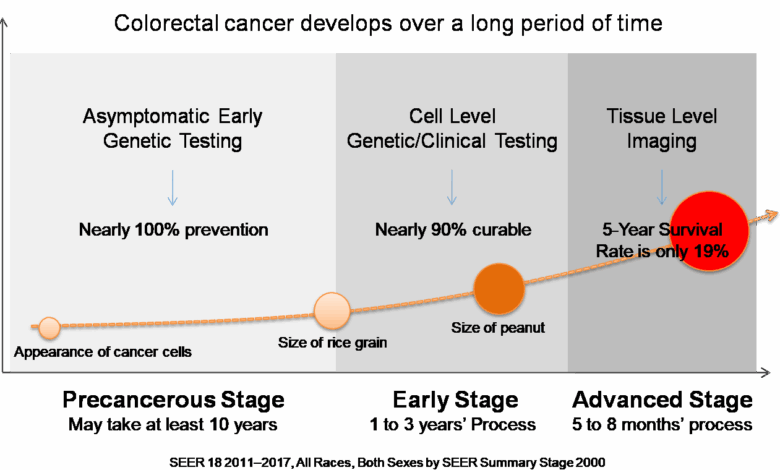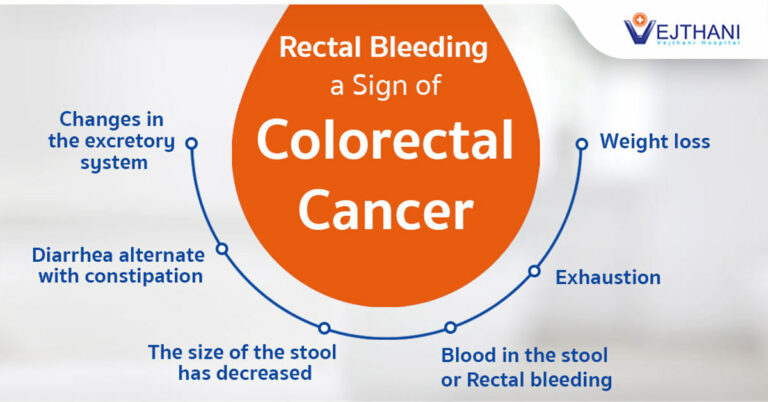
Detecting colon cancer earlier treating later – Detecting colon cancer earlier, treating later, is crucial for improving outcomes. This exploration dives into the critical strategies for early detection, highlighting screening methods, lifestyle factors, and the challenges involved. We’ll examine the impact of timely intervention, discussing treatment options and the consequences of delayed care. The journey underscores the importance of awareness and proactive steps to safeguard health.
Early detection significantly improves chances of successful treatment. Different screening methods, ranging from simple stool tests to more invasive procedures like colonoscopies, are evaluated for accuracy, cost, and invasiveness. Lifestyle choices, such as diet and exercise, play a substantial role in risk reduction, and family history and ethnicity are also considered. The discussion will address common barriers to screening, such as cost and patient awareness, offering solutions like improved access and public awareness campaigns.
Technology’s role in enhancing early detection will also be explored.
Early Detection Strategies
Understanding the various methods for detecting colon cancer early is crucial for improving outcomes. Early diagnosis significantly increases the chances of successful treatment and improved patient prognosis. Proactive screening plays a vital role in this process, enabling interventions before the disease progresses to advanced stages.Colon cancer, if detected early, is highly treatable. This is primarily due to the fact that cancerous growths at the initial stages are often smaller and less likely to have spread to other parts of the body.
Early detection significantly enhances the success rate of treatment.
Common Screening Methods
Early detection of colon cancer hinges on the use of various screening methods. These methods aim to identify precancerous polyps or cancerous growths in the colon before they cause significant symptoms. Choosing the most appropriate screening method depends on individual risk factors, including age, family history, and personal health conditions.
- Colonoscopy: A colonoscopy involves inserting a flexible tube with a camera into the rectum to visualize the entire colon. This allows for direct observation of the colon lining, enabling the detection of polyps or cancerous growths. Colonoscopies are generally considered the gold standard for colon cancer screening due to their high accuracy in detecting abnormalities.
- Stool Tests: These tests analyze samples of stool for the presence of blood or specific genetic markers associated with colon cancer. Stool tests are less invasive than colonoscopies and are often used as a first-line screening method for individuals who are not considered high-risk. There are different types of stool tests, each with varying degrees of accuracy and sensitivity.
- Virtual Colonoscopy (CT Colonography): A virtual colonoscopy uses X-rays and computer technology to create detailed images of the colon. This method avoids the need for a colonoscope, making it less invasive than a traditional colonoscopy. However, its accuracy might be lower than a traditional colonoscopy, and certain types of polyps might be missed.
Benefits and Drawbacks of Screening Methods
Each screening method has its own advantages and disadvantages. Understanding these factors is vital in making informed decisions about which screening method is best for an individual.
- Colonoscopy: Colonoscopy offers high accuracy in detecting precancerous polyps and early-stage cancers. However, it’s more invasive than other methods, involving sedation and bowel preparation, which can be uncomfortable. It also carries a small risk of complications, though these are typically rare.
- Stool Tests: Stool tests are less invasive and easier to perform than colonoscopies, requiring no sedation or bowel preparation. However, they may not detect all abnormalities and have a lower sensitivity compared to colonoscopies. Regular follow-up might be necessary for confirmation.
- Virtual Colonoscopy: Virtual colonoscopies are less invasive than traditional colonoscopies, as they avoid the need for a colonoscope. However, they may not be as accurate in detecting certain types of polyps or subtle abnormalities, and further testing may be required.
Genetic Predisposition and Screening
Genetic predisposition significantly impacts an individual’s risk of developing colon cancer. Individuals with a family history of colon cancer or specific genetic mutations are at a higher risk and often require more frequent or earlier screening. Genetic testing can identify individuals at high risk, allowing for tailored screening recommendations.
Comparison of Screening Methods
| Method | Accuracy | Cost | Invasiveness |
|---|---|---|---|
| Colonoscopy | High | Moderate | Moderate |
| Stool Tests | Moderate | Low | Low |
| Virtual Colonoscopy | Moderate | Moderate | Low |
Factors Affecting Early Detection

Understanding the factors that influence colon cancer risk and early detection is crucial for prevention and successful treatment. Early detection significantly improves survival rates, highlighting the importance of proactive measures and lifestyle choices. This section delves into the interplay of lifestyle, genetics, and other contributing factors in the development of colon cancer and how they impact screening recommendations.Lifestyle factors play a substantial role in determining an individual’s risk of developing colon cancer.
A combination of healthy habits, including a balanced diet, regular exercise, and maintaining a healthy weight, can significantly reduce the risk. Conversely, certain lifestyle choices can increase the likelihood of developing the disease. Early detection rates are also influenced by these factors, as individuals who adopt healthier habits are more likely to participate in screening programs.
Lifestyle Factors and Colon Cancer Risk
A balanced diet rich in fruits, vegetables, and whole grains is linked to a lower risk of colon cancer. Conversely, a diet high in processed meats, red meat, and saturated fats has been associated with an increased risk. Regular physical activity helps maintain a healthy weight and reduces inflammation in the body, both of which contribute to a lower risk of colon cancer.
Maintaining a healthy weight is essential for reducing the risk of colon cancer, as obesity is a significant risk factor.
- Diet: A diet rich in fiber, fruits, and vegetables provides essential nutrients and promotes healthy digestion, reducing the risk of colon cancer. Conversely, diets high in processed meats and red meat can increase the risk. For example, studies have shown a correlation between high red meat consumption and a higher incidence of colon cancer.
- Exercise: Regular physical activity helps maintain a healthy weight, reduces inflammation, and improves overall health, which in turn contributes to a lower risk of colon cancer. Examples include brisk walking, jogging, swimming, or cycling.
- Weight Management: Maintaining a healthy weight is crucial in reducing the risk of colon cancer. Obesity is a significant risk factor, and studies have demonstrated a strong correlation between higher body mass index (BMI) and an increased risk of the disease. For instance, a person with a BMI over 30 is at a higher risk compared to someone with a healthy BMI.
Family History and Ethnicity in Screening
Family history of colon cancer significantly impacts screening recommendations. Individuals with a strong family history, especially if diagnosed at a younger age, may need to start screening earlier and more frequently than those without a family history. Furthermore, certain ethnic groups have a higher risk of developing colon cancer. This is crucial in tailoring screening guidelines to specific populations, acknowledging that these differences exist.
- Family History: A family history of colon cancer, particularly if diagnosed at a young age or multiple family members have been affected, significantly increases an individual’s risk. This often warrants more aggressive and earlier screening measures, potentially including genetic testing in some cases.
- Ethnicity: Certain ethnic groups have a higher prevalence of colon cancer. For example, African Americans have a higher risk compared to some other ethnic groups. This information is critical in developing targeted screening programs and public health initiatives to reduce disparities in early detection and treatment outcomes.
Risk Factor Impact on Detection
| Risk Factor | Impact on Detection | Mitigation Strategies |
|---|---|---|
| High Red Meat Consumption | Increased risk, potentially delayed detection due to inflammation and potentially altered bowel function | Reduce red meat intake, increase consumption of fruits, vegetables, and whole grains |
| Obesity | Increased risk, potential for delayed detection due to masking symptoms or affecting screening access | Maintain a healthy weight through diet and exercise |
| Family History of Colon Cancer | Increased risk, potentially necessitating earlier and more frequent screening | Consult with a healthcare provider for personalized screening recommendations |
| Age | Risk increases with age, requiring more frequent screening | Adhere to recommended screening guidelines based on age and risk factors |
| Certain Ethnicities | Higher risk in some groups, demanding tailored screening programs | Consult with a healthcare provider to understand appropriate screening guidelines for your ethnicity |
Challenges in Early Detection
Early detection of colon cancer is crucial for successful treatment and improved survival rates. However, several significant obstacles hinder widespread adoption of screening programs. These challenges encompass a range of factors, from financial limitations and logistical barriers to psychological and emotional concerns. Understanding these hurdles is essential to developing effective strategies for increasing early detection rates.Identifying and overcoming these barriers is vital to expanding access to life-saving colon cancer screenings.
By addressing the challenges head-on, we can move closer to a future where colon cancer is diagnosed at its earliest, most treatable stage.
Common Barriers to Screening
Many individuals face significant obstacles when considering colon cancer screening. Financial constraints, limited access to healthcare, and a lack of awareness all contribute to lower screening rates.
- Cost: The cost of colonoscopy and other screening procedures can be prohibitive for many individuals, particularly those with limited financial resources. The expense of tests, procedures, and potential follow-up care can create a significant barrier to access. For example, insurance coverage can vary widely, and even with insurance, co-pays and deductibles can be substantial. Uninsured individuals are often excluded from screening altogether.
- Access: Geographic limitations and scheduling difficulties can also hinder access to colon cancer screening. Lack of convenient screening locations, long wait times for appointments, and transportation challenges can make it difficult for individuals to participate in screening programs. This is especially true for individuals in rural areas or those with limited mobility.
- Patient Awareness: Many individuals remain unaware of the importance of colon cancer screening or the availability of screening programs. A lack of knowledge about risk factors, recommended screening guidelines, and the benefits of early detection can result in delayed or missed screenings. This lack of awareness is often compounded by misinformation or misconceptions about the screening process.
Psychological and Emotional Factors
Beyond practical barriers, psychological and emotional factors can influence individuals’ decisions regarding colon cancer screening. These factors often stem from fear, anxiety, or discomfort associated with the screening process.
Early detection of colon cancer is crucial for successful treatment. However, factors like lifestyle choices, such as the unhealthy eating habits of overweight young adults likely to binge, potentially contribute to a higher risk. This emphasizes the importance of focusing on preventative measures, including healthy diets and regular check-ups, to detect colon cancer earlier and improve treatment outcomes.
- Fear and Anxiety: The prospect of undergoing a colonoscopy or other screening procedure can evoke significant fear and anxiety in some individuals. The potential for discomfort, pain, or unpleasant experiences can deter individuals from seeking screening. For example, some individuals might be hesitant due to past medical experiences or a general apprehension toward medical procedures. Addressing these fears with thorough information and empathetic communication is crucial.
- Embarrassment and Discomfort: Some individuals may experience embarrassment or discomfort related to the intimate nature of colon cancer screening procedures. Cultural or personal sensitivities can contribute to hesitancy. Open communication and culturally sensitive approaches to screening are important to address these concerns.
- Perceived Risk: An individual’s perception of their personal risk for colon cancer can influence their decision to undergo screening. Those who feel they are not at high risk may delay or avoid screening altogether. However, the truth is that colon cancer can affect anyone. Health professionals should emphasize the importance of screening for everyone within the recommended age range.
Strategies to Address Challenges
Overcoming these obstacles requires a multi-faceted approach that addresses the practical, psychological, and emotional aspects of screening.
- Improving Access to Affordable Screening: Expanding access to affordable screening options is crucial. This includes increasing insurance coverage for screening procedures, providing financial assistance programs, and establishing community-based screening programs in underserved areas. Examples of such initiatives include mobile screening units and discounted or free screening options in low-income communities.
- Promoting Public Awareness Campaigns: Public awareness campaigns play a vital role in educating the public about the importance of colon cancer screening. These campaigns should highlight the benefits of early detection, dispel myths and misinformation, and promote a positive and encouraging message about the screening process. For instance, community outreach events and educational materials can be developed to target specific demographics.
- Developing Culturally Sensitive Outreach Programs: Culturally sensitive outreach programs are essential for reaching diverse populations. These programs should consider the unique cultural beliefs, values, and practices of different communities. This includes working with community leaders and healthcare providers who understand and respect the cultural nuances of their communities. For example, translation services and culturally appropriate educational materials can help increase participation.
Technological Advancements, Detecting colon cancer earlier treating later
Technological advancements offer exciting possibilities for improving colon cancer screening and diagnosis.
- Innovations in Screening Methods: New screening methods, such as stool-based tests and virtual colonoscopies, offer less invasive options than traditional colonoscopies. These innovations can improve patient comfort and potentially reduce the cost and logistical barriers associated with traditional procedures. For example, stool tests can detect hidden abnormalities in the early stages of the disease. Virtual colonoscopies reduce the need for sedation and recovery time, making the process more convenient.
- Diagnostic Tools: Advancements in diagnostic tools can improve the accuracy and speed of detecting colon cancer. For example, improved imaging techniques and molecular diagnostics can lead to earlier and more precise diagnoses, ultimately improving treatment outcomes. Such advancements allow for more targeted and effective treatments.
Treatment Approaches: Detecting Colon Cancer Earlier Treating Later

Navigating the treatment landscape for colon cancer hinges critically on the stage of the disease. Early detection offers a significantly higher chance of successful treatment and long-term survival. Understanding the different treatment options and their suitability for various stages is crucial for patients and their healthcare providers. Tailoring the treatment plan to the individual patient’s unique characteristics is paramount for optimal outcomes.
Early detection of colon cancer is crucial for successful treatment. While focusing on health, it’s also important to encourage outdoor play in kids. Investing in some fun, engaging toys, like those found in the best toys to get kids outside list, can help them develop healthy habits. Ultimately, proactive health measures, both for ourselves and our kids, are key to a better future.
Early detection remains vital in the fight against colon cancer.
Various Treatment Options
Treatment approaches for colon cancer encompass a range of modalities, each playing a distinct role in the overall management strategy. These options vary depending on the stage of the disease, the extent of the cancer, and the patient’s overall health. The primary treatment options include surgery, chemotherapy, radiation therapy, and targeted therapies.
Surgery
Surgical resection is often the cornerstone of treatment for colon cancer, particularly in early stages. The type of surgery depends on the location and extent of the tumor. For early-stage disease, a colectomy, which involves the removal of the affected portion of the colon, may be sufficient. In advanced stages, more extensive procedures might be necessary, such as a more extensive resection or even a colostomy.
The goal of surgery is to remove the cancerous tissue and surrounding healthy tissue to minimize the risk of recurrence.
Chemotherapy
Chemotherapy uses drugs to kill cancer cells. It can be used in conjunction with surgery, before surgery (neoadjuvant therapy), or after surgery (adjuvant therapy) to reduce the risk of recurrence. In advanced-stage disease, chemotherapy may be used as the primary treatment approach or as part of a combination therapy regimen. The specific chemotherapy regimen depends on factors like the stage of the cancer, the patient’s overall health, and the specific tumor characteristics.
Early detection of colon cancer is crucial, and unfortunately, a healthy diet plays a vital role. The quality of diet for older adults has declined in recent years, impacting overall health, and, potentially, increasing the risk of developing colon cancer. Check out this helpful guide for tips on improving dietary habits. Ultimately, focusing on a nutritious diet is key for not only preventing but also detecting colon cancer earlier, which can significantly impact treatment outcomes.
Radiation Therapy
Radiation therapy uses high-energy beams to damage cancer cells. It can be used to shrink tumors before surgery (neoadjuvant therapy) or to reduce the risk of recurrence after surgery. It is often used in combination with chemotherapy for advanced stages of the disease. Radiation therapy can be administered externally or internally.
Targeted Therapies
Targeted therapies are designed to specifically target cancer cells while minimizing harm to healthy cells. These therapies often target specific genetic alterations or proteins involved in the growth and spread of cancer. They are commonly used in advanced-stage disease and are increasingly being employed in combination with other treatments, such as chemotherapy. They may also be utilized in the context of recurrence.
Personalized Treatment Plans
A personalized treatment plan is crucial for optimal outcomes. This plan takes into account the specific characteristics of the cancer, including its location, stage, grade, and genetic profile. The patient’s overall health, age, and preferences also play a significant role in determining the most appropriate treatment strategy.
Table of Treatment Options and Suitability
| Treatment | Stage Suitability | Effectiveness |
|---|---|---|
| Surgery | Early, Advanced | High in early stages, effective in advanced stages with combination therapies |
| Chemotherapy | Early, Advanced | Effective in reducing recurrence risk and treating advanced disease |
| Radiation Therapy | Early, Advanced | Effective in shrinking tumors and reducing recurrence risk, often used in combination |
| Targeted Therapies | Advanced | Effective in targeting specific genetic alterations and proteins in advanced disease |
Impact of Delaying Treatment
Delaying treatment for colon cancer can have devastating consequences, significantly impacting survival rates and overall quality of life. The longer the cancer is left untreated, the more likely it is to spread, making treatment more complex and less effective. Understanding the impact of delayed treatment is crucial for promoting early detection and timely intervention.
Consequences of Delayed Treatment
Delaying treatment for colon cancer allows the disease to progress, leading to a cascade of negative effects. The cancer cells can spread to other parts of the body (metastasize), making it much harder to treat. This spread often occurs through the bloodstream or lymphatic system, potentially affecting vital organs and tissues. Metastasis significantly reduces the effectiveness of treatment and increases the risk of recurrence.
Decreased Survival Rates
The stage of colon cancer at diagnosis directly correlates with the chances of successful treatment and overall survival. Early-stage cancers, detected and treated promptly, have a significantly higher survival rate compared to late-stage cancers. Delaying treatment allows the cancer to grow and spread, reducing the effectiveness of treatment options and lowering the chances of a positive outcome. Studies consistently show a strong correlation between the timeliness of diagnosis and treatment and patient survival.
Examples of Improved Outcomes with Early Detection
Early detection and treatment of colon cancer significantly improve outcomes. A patient diagnosed with stage I colon cancer, for instance, has a much higher chance of complete remission compared to a patient diagnosed with stage IV. Early intervention allows for less invasive treatments, potentially preserving the patient’s quality of life and increasing the likelihood of a full recovery.
This is further exemplified by the success stories of individuals who underwent surgery for early-stage colon cancer and have gone on to live healthy and productive lives.
Impact on Overall Health and Quality of Life
Delaying treatment for colon cancer negatively affects a patient’s overall health and quality of life. The symptoms of the disease, along with the side effects of treatment, can lead to fatigue, pain, and discomfort. This can impact the patient’s ability to perform daily tasks, engage in social activities, and maintain their emotional well-being. The psychological impact of a delayed diagnosis and treatment can be profound, leading to anxiety, depression, and fear.
Stage of Cancer and Treatment Options
The stage of cancer at diagnosis significantly influences the available treatment options and the expected prognosis. Early-stage cancers are often treatable with surgery alone, while late-stage cancers may require a combination of surgery, chemotherapy, radiation therapy, and targeted therapies. The choice of treatment depends on several factors, including the location and extent of the cancer, the patient’s overall health, and their preferences.
Early-stage cancers have a higher likelihood of being completely eradicated, while late-stage cancers may still be treatable, but the likelihood of complete remission and long-term survival is reduced.
Promoting Early Detection Awareness
Early detection is crucial in the fight against colon cancer. By raising awareness and educating the public about screening, we can significantly improve outcomes. This involves not only understanding the importance of early detection but also empowering individuals to take proactive steps towards their health. Early detection strategies, coupled with proactive screening, lead to improved treatment options and a higher chance of survival.Understanding the importance of early detection empowers individuals to make informed choices about their health.
By disseminating accurate information and fostering a supportive environment, we can create a culture of preventative health. This culture is essential in combating colon cancer and ultimately saving lives.
Public Service Announcement (PSA) Script
This PSA script aims to create a memorable and impactful message about colon cancer screening.
“A simple test can save your life. Colon cancer often has no symptoms in its early stages. Regular screenings, like colonoscopies, can detect polyps – abnormal growths that may become cancerous – before they develop into cancer. Don’t delay. Schedule your screening today. Visit [website address] to find a doctor near you.”
The script utilizes a concise, direct tone to convey the urgency and importance of early detection. It highlights the potential for early detection to prevent severe consequences. The call to action is clear and straightforward, encouraging viewers to take immediate steps towards their health.
Social Media Posts
Social media provides a powerful platform to disseminate information and engage with the public. These posts will focus on visually appealing graphics and easily digestible information.
- Post 1: A striking infographic showcasing the prevalence of colon cancer and the success rates of early detection. The infographic will highlight the significant difference in treatment success between early and late detection.
- Post 2: A short video featuring a personal story of someone who benefited from early detection. The video will focus on how early intervention made a difference in their life. The tone will be hopeful and inspiring.
- Post 3: A poll asking users about their knowledge of colon cancer screening. The poll will be engaging and will highlight common misconceptions and provide correct information in the results.
- Post 4: A humorous yet informative graphic that contrasts the simplicity of screening with the potentially devastating consequences of delaying it. The post will use relatable imagery and a conversational tone.
- Post 5: A Q&A session with a healthcare professional addressing common concerns about colon cancer screening. This will build trust and provide clarity on frequently asked questions.
These posts aim to engage the audience through visual appeal, relatable stories, and informative content. They utilize diverse formats to reach a wider audience.
Actionable Steps for Community Promotion
Creating a community-wide initiative for colon cancer awareness requires a multi-faceted approach.
- Organize community events: Host health fairs, workshops, and seminars to educate the public about colon cancer screening and provide resources. These events should be accessible and engaging, catering to different learning styles and needs.
- Partner with local organizations: Collaborate with schools, community centers, and businesses to distribute educational materials and encourage screening. This will maximize reach and impact.
- Develop community outreach programs: Create a network of volunteers who can spread awareness and provide support to those in need. The volunteers should be trained to answer questions and address concerns.
- Create a local support group: Support groups provide a vital network for individuals affected by colon cancer, their families, and caregivers. They provide a space for emotional support and shared experiences.
- Promote awareness through social media campaigns: Utilize targeted advertising and collaborations with local influencers to reach a wider audience. The campaign should be consistent and sustained to maintain awareness.
These steps emphasize community involvement and collaboration. A unified effort can create a significant impact in raising awareness and encouraging early detection.
End of Discussion
In conclusion, detecting colon cancer early is paramount to successful treatment. Understanding the various screening methods, lifestyle factors, and potential challenges is vital. Early detection significantly impacts treatment options and prognosis, highlighting the need for proactive measures. By addressing barriers and fostering awareness, we can improve outcomes and empower individuals to take control of their health. Ultimately, early detection empowers individuals to make informed decisions about their health, and it emphasizes the importance of prompt and personalized treatment plans.




